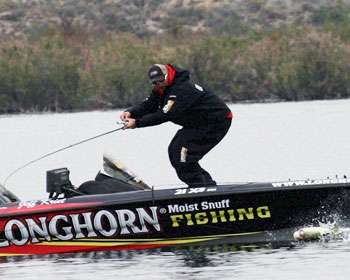
For many Elite Series pros, the 10-inch worm is the workhorse in their arsenals during the postspawn and summer. In 2008, Paul Elias, Kenyon Hill and Jeremy Starks all relied on the big worm on their way to Elite Series victories, and more recently, Bobby Lane employed a 10-inch worm to capture the crown at the Elite Series event on Kentucky Lake.
Oklahoma pro Jeff Kriet is another Elite Series angler who is a proponent of going big when the water warms up. "I really like to use a big worm after the spawn, when the bass move out (toward deeper water). I throw it all the time," says Kriet, who uses his namesake Big Bite Baits Kriet Tail Worm. In warm water, he believes, you'll get more bites on a big ribbontail worm than you will on a little worm.
Kriet believes that the 10- to 12-inch worms become so effective because, as the water temperature rises, the bass essentially become lazy and won't waste energy chasing smaller baits. "When it gets really hot the bass won't eat a lot, but when they do, they want a big bait that is going to be a meal," Kriet explains.
The big worm paid off for Kriet during the 2008 Elite Series stop at Old Hickory Lake in June. "At Old Hickory, I couldn't get bit on a little worm. When the water gets hot and the conditions are tough, I just think that the bass don't feed as much." Flipping a magnum ribbontail worm around shallow cover, Kriet was able to secure a Top 50 finish in the tournament. "On a highly pressured lake, a lot of anglers will be flipping little worms or tubes, but sometimes that bigger profile bait is just the deal," Kriet says.
In Kriet's experience, a big worm doesn't take a heavy slip sinker. He isn't afraid to go light, using bullet weights as light as 1/4 ounce when fishing the big worm in shallow water. When probing ledges and deep water haunts, he favors a 5/16-ounce weight for dragging the bottom, and when the bass seem to want the worm on a sharp hop, he'll switch to a heavier, 3/8- or 1/2-ounce, slip sinker.
When dragging the worm in deep water, Kriet will alter his retrieve until he finds one the bass are reacting to. "I like to throw it around the ledges and hard bottoms and drag it a lot until I hit something. Then I'll slow down and shake the worm over the logs and rocks," Kriet explains.
If he is unable to get bites by dragging the worm, Kriet will fish the worm in a more aggressive manner by sharply hopping it. He lets the worm go to the bottom and then snaps his rod tip really high to cause the worm to leap off the bottom. Often, the bass hit it as it falls back toward the bottom.
Water clarity is another factor the Oklahoma pro takes into consideration. Kriet believes that the big worm shines when the water is slightly stained, although he isn't reluctant to fish it in clear water. The only time he keeps the worm rod in storage is when he is fishing in extremely muddy water. "Big worms move a lot of water, so when there's a little stain I'll actually swim the worm around cover," explains Kriet.
He also points out that while the big worm has a tendency to garner quality bass, smaller bass attack the offering without hesitation. "I've caught some 12-inch bass on a 10-inch worm. That being said, I do catch a lot of bigger fish on a big worm," he admits. "I guess people are afraid of it, but I promise you, there are times when you'll get more bites on a big worm than a little one."




